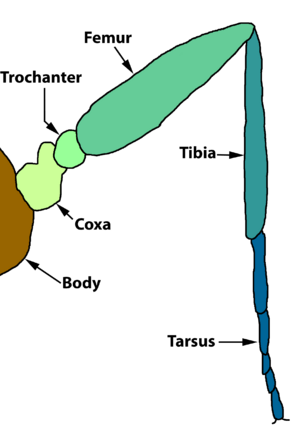Tarsal formula facts for kids
The tarsal formula is a special way to count the tiny parts that make up the "foot" section of an arthropod's leg. Think of an arthropod as a creature with an outside skeleton, like insects, spiders, and crabs. The "foot" part is called the tarsus. It's the very end of the leg, usually touching the ground, as you can see in the diagram.
Contents
What is a Tarsal Formula?
A tarsal formula uses three numbers, like "5-5-4", to describe how many segments (small sections) are in the tarsi of an insect's legs. Each number stands for a different pair of legs:
- The first number (a) tells you about the front legs.
- The second number (b) tells you about the middle legs.
- The third number (c) tells you about the back legs.
How to Read the Formula
Let's use the example "5-5-4". This means:
- The front legs each have 5 segments in their tarsi.
- The middle legs each have 5 segments in their tarsi.
- The back legs each have 4 segments in their tarsi.
These segments are often very small and can be hard to see without a magnifying glass!
Why is the Tarsal Formula Useful?
Scientists and insect enthusiasts use the tarsal formula to help them figure out what kind of insect they are looking at. It's like a secret code that helps identify different insect families or groups.
Identifying Insects
Just like fingerprints help identify people, the tarsal formula can help identify insects. Different types of insects often have unique tarsal formulas. For example, many beetles have a 5-5-4 formula, but others might have 3-3-3 or 4-4-4. By carefully counting these tiny segments, experts can narrow down the possibilities and correctly identify an insect. This is especially helpful when trying to tell apart insects that look very similar.
Understanding Insect Anatomy
Studying the tarsal formula also helps us understand how insect bodies are put together. The number and shape of these segments can affect how an insect walks, climbs, or even holds onto things. For example, some insects have special pads or claws on their tarsi that help them grip surfaces.


